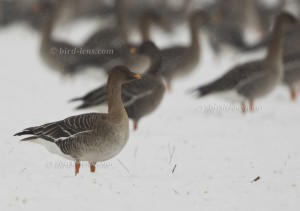Although the winter’s chill hold finally broke last week the wintertime is not over, already. The mild conditions and temperatures of up to around 8 degrees did not last for a long time. By 19th a Scandinavian high pressure was fully in charge and a strengthening easterly flow and increasing cloud cover ensured that temperatures were soon heading all the way back down again.
Not only the common songbirds responded well to the rapidly lengthening days and the suddenly mild conditions but also the first returning cranes. But these are early days indeed for spring migrants.
So it was quite a surprise to find at least 7 Common Crane (Grus grus) on an open field in the mist of the snow in the northern part of the nice Nature Reserve One called Knoblochaue. Together with its sister reserve Kuehkopf this reserve is famous for being the best riparian forest location not too far south of Frankfurt. The nature reserve (in german: Naturschutzgebiet or NSG) is a European Reserve und an excellent birding spot year-round.
As nice images of the Bean Goose of the (Sub-)species Tundra Bean Goose (Anser (fabalis) serrirostris), were still missing on bird-lens.com, I decided to visit the meadows on the northern side of the reserve called Leopoldsgewann as in winter the fields to the north of the Godellau (between Leeheim and Erfelden) access-road hold vast numbers of Bean Geese. There was also a twitch of a Pink-footed Goose (Anser brachyrhynchus) nearby. So I gave it a try – although (or because) heavy snow and temperatures around zero Celsius were forecasted. When I arrived I was lucky to have good flocks of Tundra Bean Goose (which certainly exceeded the number of 250 individuals) together with Greylag Goose (Anser anser) and a few Greater White-fronted Goose (Anser albifrons). As this flat area is a reknown nature area in a densely populated countryside there is often some disturbance by joggers or people who go with their dogs. So the good numbers of Geese not to far away from field roads were astonishing. But the biggest surprise were 7 Common Crane (Grus grus) on the fields. Obviously they had to land down on their way back to their breeding grounds in northern Europe when the weather worsened. At the end the luck was completed by in total 3 Northern Harrier (Circus cyaneus) – 2 female, 1 male – circling over the snow-covered countryside. That the luck in this birding experience was triggered by the weather you could see the next day. On a sunny morning, no cranes, no harriers and by far the geese not so close by.
The nature reserve Kuehkopf-Knoblochsaue is the largest in Hesse, with 2,369 hectares. It is located on the right bank of the upper rhine. The nature reserve Kuehkopf-Knoblochsaue is a riparian landscape in the natural flood plain of the Rhine. It is made up of water, mud fields, reed-beds, floodplain meadows and soft wood forest (willows and poplars) and hard wood forest (including oak and elm). The area has a birdlist of about 250 species of bird. Approx. 120 species of birds breed here, including the White Stork (Ciconia ciconia). So the reserve is famous more as being a spring/summer birding destination, but in wintertime it can be very good, too with large concentrations of geese and ducks, like Tundra Bean Goose and Garganey (Anas querquedula). One of the bonuses is the fact, that the open fields act as a wintering ground for good numbers of Northern Harrier (Circus cyaneus). In winter the fields to the north of the reserve is famous for being a wintering stronghold for Tundra Bean Geese. At that time of the year the river Rhine also holds some rare sea ducks, and you might see Common Eider (Somateria mollissima), Common Goldeneye (Bucephala clangula), Smew (Mergellus albellus), Common Merganser (Mergus merganser) and even a small flock of Velvet Scoter (Melanitta fusca) there.
Hope all this give you a short impression what is possible quite close to Frankfurt Airport even in wintertime.
Feel free to contact me. I am are always interested in getting feedback from birders both before and after their visits to Frankfurt: you can help us improve facilities and also provide us with more info on birds around Frankfurt in the Rhein-Main area. Bird-lens is very interested in expanding our knowledge of birdlife in the area. In general we have a good overview of much, but bird info on good numbers, rarities, nice photos, etc is always very interesting.
You are most welcome to Frankfurt, and we are happy to help you out with info and advice!
A short blog in the series “Where to watch birds near Frankfurt” is already in preparation. Here bird-lens.com will give you more information, what to see when and how to get there.

Sorry to read abouth the common lapwings and other migrators. We in Sweden are waiting for our summerguests , ex in the crane-district of Hornborga. This time of the spring there use to bee at least some hundered up to 7.000 cranes but until todayl no one has arriwed 🙁 The weather in the aera are icy and cold and the lake is frozen.
Me and some friend in the national network Strandskatorna(oystercatcher)we live in northern Sweden and are travelling to Hornborga lake in the south next tuesday. We are hoping for the best.
Last year we hade a record för arriwing of common lapwing in Luleå/Norrbotten, it arriwed the 10-th of mars!
Yes, this is a really hard time for them in Germany as well. Now we have still minus-degrees – and it is supposed to be like this for more days. Recently I saw a flow of cranes high up in the sky returning from the north…..